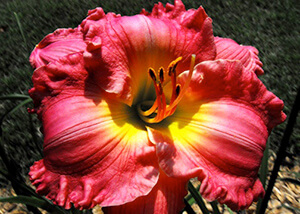
The versatile and colorful daylily.
Summer’s here when the daylilies bloom. The flowers feature more than 80,000 named varieties ranging from single and double blooms to those with ruffled petals and others as large as dinner plates. Serious collectors have been known to pay upward of $800 for a single hybrid plant, but for the average gardener, the price range of around $5 to $8 can add an explosion of color to your landscape.
If you want to see some amazing blooms grown by collectors, visit the North Georgia Daylily Society’s show on Saturday, June 11. It takes place in Athens at the State Botanical Garden of Georgia. They will have plants for sale as well as prize-winning blooms that will take your breath away. Here’s the link to the group: www.northgeorgiadaylilysociety.com.
Daylilies are known for being easy-care, drought-tolerant plants that thrive in sun. They will come back year after year, but they do need proper care.
They need well-drained soil and full sun for at least four to six hours a day. If you fertilize them in the spring and again in the fall, you’ll be rewarded with more blooms and healthier plants. Water them deeply at least once a week when it’s really dry.
Daylilies grow from fleshy roots and produce clumps of leaves, called fans. Look for plants, whether they are in pots or bare root, with more than one fan. Box retailers are a good place to purchase them potted and many have multiple fans. They’ll be the more common varieties, such as the petite Stella D’oro yellow or burgundy, one-color red, burgundy, yellow or orange in singles and doubles.
More exotic daylilies may have multi-colored blooms, ruffled edges or double blooms. They’re very showy, but the showier they are, the more expensive they will be to purchase.
Daylilies have many uses in the landscape. They can line driveways or walkways, be massed in large swaths in sunny gardens, planted in rows behind shorter perennials or annuals of complementary or contrasting colors, or grown in pots on a porch or patio.
If planting daylilies with other perennials, such as lavender, coneflowers or Shasta daisies, make sure that the companion plants are compatible regarding type of soil, moisture and light requirements of daylilies.
Planting and care guide
– Select a location with four to six hours of direct sun.
– Plant in well-drained, not soggy, soil, amending it with compost or other organic matter.
– Combine early, mid- and late-blooming varieties to maximize the flower show.
– A light layer of mulch will help reduce weeds and help hold in moisture.
– Water early in the morning at least once a week when the weather is dry.
– Feed with 10-10-10 basic fertilizer in the spring and again in the fall.
– Divide daylilies every three to five years in late summer when they’ve finished blooming. Replant and share with friends and neighbors. This will help them grow better and reduce crowding.
Pot up some of the divisions, keep them watered and share them with friends the next spring. They’re the perennial that keeps on giving whether you’re planting them in your landscape or sharing them.
Photo: by Pamela A. Keene





